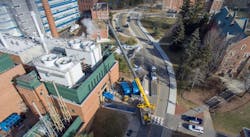Creating New Campus Power for Future Generations: A Case Study of CHP upgrades at the UCONN Campus
If education truly is the most powerful weapon in changing the world for the better, as many legends have said, then a university campus is many times the centerpiece of building that intellectual strength ready to go out and improve the world.
And, not to be selfish, but it helps if the buildings housing those efforts are warm when it’s cold outside and comfortable when the summer is hot. To those key points, the University of Connecticut recently had extensive upgrades and replacements made to its central utility plant and built in a supplement power system to accommodate its growth at the main Storrs campus.
Craig Parker of BVH Integrated Services and John Turner of BOND Brothers Inc. spoke about the massive project during the International District Energy Association’s CampusEnergy2022 conference in Boston. They were part of a intensive construction phase which have to operate in tight quarters, while class was in a session and COVID-19 raging.
“We had to learn to work in this new environment, as everybody did,” said Turner, who is the project executive for Bond, which led the work on the Central Utility plant.
UCONN has more than 19,000 students attending at its Storrs campus. The school continues to grow and its utility needs included 265,000 pounds an hour of steam demand projected to rise to a need for 340,000 pph by 2035.
The work, which was completed at the Central Utility plant ending November 2020, included replacement of four gas-fired chillers, heat exchangers and pumps as well as cooling towers.
Not only did the teams involving BOND and BVH have to operate around existing buildings and sometimes students moving to and fro, but also faced many footprint, excavation and positioning challenges.
“It was a critical time of getting infrastructure in place,” said Parker, the consulting engineer with BVH Integrated Services. “The challenge is the existing central utility plant is coupled with a cogeneration facility. . . not a lot of room on campus (and) …there was a lot of people moving forward.”
Three of the four boilers were also moving out of NOX (nitrogen oxide emissions) compliance within a few years, so needed to be replaced. The crews had to take up the work in stages, and were backed by a grid connection and a 4,000 kW diesel generator as emergency backup when needed.
The cogeneration plants produce both electricity and heating steam for campus-wide use. The gas turbines are dual-fuel which could run on No. 2 fuel oil or natural gas, but the heat return steam generators utilized duct burners on gas only.
Despite many challenges, the teams working at UCONN got the job done. College campuses around the country are both growing numerically while trying to meet sustainability goals.
They need on-site power, such as CHP-cogeneration plants, backup generators and renewables. When handling such a project as an overhaul of one site and building a new supplemental plant, the key point is preparation.
“Pre-construction is the path to success,” Turner said. “Site analysis, site logistics development, having rigging paths worked out…”
IDEA’s CampusEnergy2022 conference ended Friday with site tours of various plants and projects. It represents more than 2,400 members across dozens of nations where CHP and district energy are utilized in the power generation mix.
On-site CHP plants are considered highly efficient because they convert the excess heat used in power generation to create steam, hot or chilled water which can be used either in comfort solutions or industrial processes.
-- -- --
(Rod Walton, senior editor for EnergyTech, is a 14-year veteran of covering the energy industry both as a newspaper and trade journalist. He can reached at [email protected]).





